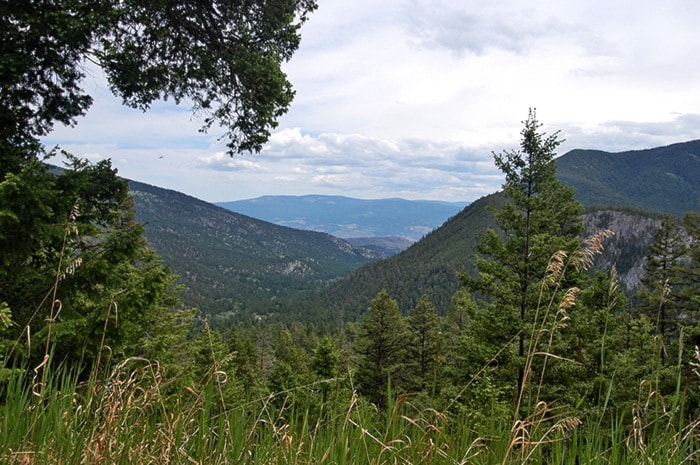Several years ago a friend who lives in Ashcroft had occasion to travel by plane from Vancouver to Kamloops. Her seatmate was another woman, a stranger, who hailed from the Lower Mainland. This was just at the time when the ravages of the pine beetle epidemic were beginning to be seen this far south, and they both gazed out at the fingers of rusty red spreading through the green carpet far below them as they flew near Merritt.
Eventually the stranger said “I don’t see why they can’t stop it; all someone has to do is cut down all the infected trees.”
I don’t know what my friend said in answer; presumably she was too open-mouthed with amazement to form a reply. The incident does highlight, though, how the immensity of the Interior defies belief, even when seen from the air. It’s the reason why someone can think, apparently in complete seriousness, that chopping down all the infected trees is possible; and it’s why many people probably have a hard time realizing how terrifyingly easy it is to become lost in this area, even with modern technology to help those who are lost and the people searching for them.
Now imagine how difficult it would have been to locate a lost person 100 years ago, when even printed maps (if they existed for the area) would not have been completely accurate. On May 21, 1913 Mrs. Adam Young, the wife of a farmer near Venables Valley, left her house for a walk early one morning, as she had been in the habit of doing for some days. The Youngs already had two grown sons and a daughter living in Ashcroft, and had recently arrived from England to join them here, taking up land about 12 miles west of the town. Mrs. Young had been in poor health, and the walks she took were not lengthy. When she set out that Wednesday morning, there was no reason to think the day’s walk would be any different to the others.
But it was. The hours drew on, and Mrs. Young did not return. Her husband, becoming increasingly anxious, eventually set out in search of her. When there was still no sign of his wife he sent word into Ashcroft, and a posse was immediately mustered and rushed to the spot. Their search continued over the next several days, but as time passed and no trace of Mrs. Young was found optimism began to dwindle, until finally it evaporated altogether. An article in The Journal on May 31 stated that “All hope of ever finding Mrs. Young . . . has been given up and all searching parties have been called in.”
The article continues, “It is most unlikely that the lady walked out of the country as she had neither money nor strength at the time of her disappearance.” It concludes in depressing fashion: “It is the general belief that she has destroyed herself in the creek nearby, although a most diligent search of this stream has been made without result.”
Without knowing more about Mrs. Young’s physical and mental health at the time, it is impossible to say how much credence should be given to the idea that she committed suicide. The fact remains that a woman on a “short walk” near her farm disappeared so utterly and completely that a team of searchers looking for her over the course of several days found no trace of her. It gives an idea of the terrain, and the immensity of it, that is almost incomprehensible unless you have seen it up close. Wander a few feet from the road or trail and suddenly one tree looks very much like another, as the forest closes behind you and there are no helpful signposts to point you in the right direction.
The sad postscript to Mrs. Young’s story came almost six months later. An article in The “Journal” on Nov. 8, 1913 reported that Mr. Young had discovered his wife’s body in a stream, where it had apparently drifted under a log and become completely submerged. “The position of the body explains the failure of the search parties to locate it at the time of her disappearance,” explains the article, continuing “The country in that vicinity is very hilly and is thickly wooded, and could not be covered to any satisfaction,” despite several people scouring the area for more than a week.
So where was Mrs. Young’s body found? Had she somehow managed, despite her illness, to travel a considerable distance from her farm, thus taking her outside the area the searchers concentrated on? Was she found in some other creek, far removed from the one that was searched so diligently by those looking for her? No. Mrs. Young’s body was found, the report tells us, “about 600 yards up-stream from the house in which she lived”. She had covered a distance equivalent to that of six football fields, yet those looking for her were unable to discover so much as a trace, despite focusing their efforts on that area and that stream.
Reporting on Mrs. Young’s disappearance in May, the “Journal” stated that “This is the most mysterious case that has ever been recorded in the district.” It was certainly mysterious; but does it deserve to be called the “most” mysterious disappearance that has occurred in the area? It could be argued that a disappearance from ten years earlier was even more puzzling; and unlike the case of Mrs. Young, which at least had a conclusion – however tragic – it has never satisfactorily been solved, despite a tantalizing clue being found some five years after the fact.
But that will have to wait until the next installment. . . .
Barbara Roden
